Advancing Generalizable Occlusion Modeling for Neural Human Radiance Field
IF 8.4
1区 计算机科学
Q1 COMPUTER SCIENCE, INFORMATION SYSTEMS
引用次数: 0
Abstract
Generalizable human neural rendering aims to render the target views of the human body by leveraging source views and the skinned multi-person linear (SMPL) model. Despite exhibiting promising performance, the target views rendered by previous methods usually contain corrupted parts of the human body. Two primary challenges hinder high-quality human neural rendering. These challenges involve non-correspondences between 2D pixels and 3D SMPL vertices induced by self-occlusion of the human body and erroneous appearance predictions caused by occlusion between the source and target views. To solve these two challenges, we propose an advancing generalizable occlusion modeling method for the neural human radiance field, in which the hurdles from the self-occlusion of the human body and the occlusion between source and target views are explored and solved. Specifically, to alleviate the non-correspondence problem induced by self-occlusion, a geometry perception module is designed to obtain 3D geometric representations of SMPL vertices, enabling the prediction of accurate density values. Furthermore, a visibility aggregation module is designed to estimate the visibility maps with respect to different source views by utilizing the predicted density. Then, the complementary information among multiple source views is integrated with the support of the visibility maps in the visibility aggregation module, thus effectively addressing the occlusion between views. Experiments on the ZJU-MoCap and THUman datasets show that the proposed method achieves promising performance compared with the existing state-of-the-art methods.求助全文
约1分钟内获得全文
求助全文
来源期刊

IEEE Transactions on Multimedia
工程技术-电信学
CiteScore
11.70
自引率
11.00%
发文量
576
审稿时长
5.5 months
期刊介绍:
The IEEE Transactions on Multimedia delves into diverse aspects of multimedia technology and applications, covering circuits, networking, signal processing, systems, software, and systems integration. The scope aligns with the Fields of Interest of the sponsors, ensuring a comprehensive exploration of research in multimedia.
 求助内容:
求助内容: 应助结果提醒方式:
应助结果提醒方式:


